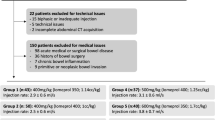Abstract
Purpose
The purpose of this study was to determine the effect of oral contrast on FDG uptake in the colon and to determine the normal distribution of FDG in the colon.
Methods
Sixty patients (30 patients in no contrast group and 30 patients in the received contrast group) underwent FDG-PET/ CT scans. The pattern of FDG uptake was classified into 5 patterns (diffuse, segmental, single-nodular, multi-nodular, and other) in 5 segments (ascending, transverse, descending, and rectosig-moid colon). SUVs of the no oral contrast group were examined. The ratios of FDG uptake patterns were compared in the received contrast group and no contrast group to evaluate the effect of oral contast. The effect of attenuation correction on the uptake pattern was evaluated by comparison of the attenuation-corrected and non-attenuation-corrected PET images.
Results
In the no contrast group, there was no significant uptake in 72 segments (59%) and a diffuse pattern was seen in 29 segments (24%), most frequently in the ascending colon and descending colon. A segmental pattern was seen in 15 segments (13%), most frequently in the rectosigmoid colon. A single-nodular pattern was seen in 3 segments (3%) and multi-nodular pattern in 1 segment (1%). A nodular pattern was seen only in the ascending colon. SUVmax of the ascending colon and that of the rectosigmoid colon were significantly higher than those of the transverse and descending colon. The frequencies of diffuse, multi-nodular and ‘other’ patterns were significantly higher in the received contrast group than in no contrast group. There was no significant difference between the frequency of the segmental pattern or the single nodular pattern in the two groups. There was no significant difference between the uptake patterns with attenuation correction and those without attenuation correction in either the received contrast group or no contrast group.
Conclusion
Normal FDG uptake in the large bowel may show various degrees and patterns of uptake among the colonic segments. Oral contrast agent can cause focal or diffuse increased FDG uptake, which may be induced not only by the high CT density of oral contrast but also by an accelerated physiologic reaction of the large bowel.
Similar content being viewed by others
References
Antoch G, Freudenberg LS, Egelhof T, Stattaus J, Jentzen W, Debatin JF, et al. Focal tracer uptake: a potential artifact in contrast-enhanced dual-modality PET/CT scans.J Nucl Med 2002; 43: 1339–1342.
Cohade C, Osman M, Nakamoto Y, Marshall LT, Links JM, Fishman EK, et al. Initial experience with oral contrast in PET/CT: phantom and clinical studies.J Nucl Med 2003; 44:412–416.
Dizendorf E, Hany TF, Buck A, von Schulthess GK, Burger C. Cause and magnitude of the error induced by oral CT contrast agent in CT-based attenuation correction of PET emission studies.J Nucl Med 2003; 44: 732–738.
Antoch G, Jentzen W, Freudenberg LS, Stattaus J, Mueller SP, Debatin JF, et al. Effect of oral contrast agents on computed tomography-based positron emission tomography attenuation correction in dual-modality positron emission tomography/computed tomography imaging.Invest Radiol 2003; 38: 784–789.
Antoch G, Freudenberg LS, Stattaus J, Jentzen W, Mueller SP, Debatin JF, et al. Whole-body positron emission tomog- raphy-CT: optimized CT using oral and IV contrast materials.Invest Radiol 2003; 38: 784–789.
Dizendorf EV, Treyer V, von Schulthess GK, Hany TF. Application of oral contrast media in coregistered positron emission tomography-CT.AJR 2002; 179: 477–81.
Beyer T, Townsend DW, Brun T, Kinahan PE, Charron M, Roddy R, et al. A Combined PET/CT Scanner for Clinical Oncology.J Nucl Med 2000; 41: 1369–1379.
Tatlidil R, Jadvar H, Bading JR, Conti PS. Incidental colonic fluorodeoxyglucose uptake: correlation with colonoscopic and histopathologic findings.Radiology 2002; 224: 783–787.
Kim S, Chung JK, Kim BT, Kim SJ, Jeong JM, Lee DS, et al. Relationship between Gastrointestinal F-18-fluorode- oxyglucose Accumulation and Gastrointestinal Symptoms in Whole-Body PET.Clin Positron Imaging 1999; 2: 273–279.
Jadvar H, Schambye RB, Segall GM. Effect of atropine and sincalide on the intestinal uptake of F-l 8 fluorodeoxyglucose.Clin Nucl Med 1999; 24: 965–967.
Antoch G, Kuehl H, Kanja J, Lauenstein TC, Schneemann H, Hauth E, et al. Dual-modality PET/CT scanning with negative oral contrast agent to avoid artifacts: introduction and evaluation.Radiology 2004; 230: 879–885.
Tietge UJ, Selberg O, Kreter A, Bahr MJ, Pirlich M, Burchert W, et al. Alterations in glucose metabolism associated with liver cirrhosis persist in the clinically stable long-term course after liver transplantation.Liver Transpl 2004; 10: 1030–1040.
Author information
Authors and Affiliations
Rights and permissions
About this article
Cite this article
Otsuka, H., Graham, M.M., Kubo, A. et al. The effect of oral contrast on large bowel activity in FDG-PET/CT. Ann Nucl Med 19, 101–108 (2005). https://doi.org/10.1007/BF03027388
Received:
Accepted:
Published:
Issue Date:
DOI: https://doi.org/10.1007/BF03027388




